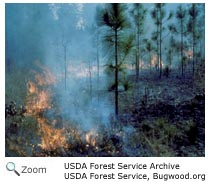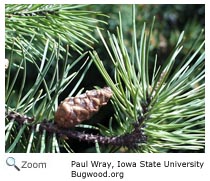Pine barrens are found in the Northeastern United States from New Jersey to Maine. They are also found in the midwest and Canada. Pine barrens get their name from their soil. The soil in pine barrens is sandy, dry, and acidic and is low in nutrients. Early settlers found the pine barrens weren't good places to grow crops and considered the land barren.
Fire!
 The first instinct man has when he sees a fire in the wild is to put it out! But sometimes, fire is needed to keep habitats healthy! Pine barrens depend on frequent fires to keep other plant species, like white pine, from taking over. Because the soil in pine barrens is so dry and sandy, plant matter like leaves, twigs, and pine needles that collect on the floor of the pine barrens doesn't decompose quickly and becomes tinder for fire! The first instinct man has when he sees a fire in the wild is to put it out! But sometimes, fire is needed to keep habitats healthy! Pine barrens depend on frequent fires to keep other plant species, like white pine, from taking over. Because the soil in pine barrens is so dry and sandy, plant matter like leaves, twigs, and pine needles that collect on the floor of the pine barrens doesn't decompose quickly and becomes tinder for fire!
 In early days, pine barrens would be cleared out by naturally occurring fire on a regular basis. The plants that made the pine barrens home would reestablish themselves and other plants not native to the pine barrens would be cleared out. As time went by, these fires would be put out by man to protect homes and other property near the pine barrens. When the fires were put out, this allowed other woody plants to take over the pine barrens. When these plants took over, some of the plants in the pine barrens that depended on open sandy areas without shade, like the wild blue lupine, couldn't survive. Many pine barrens disappeared over time as other plants took over. In early days, pine barrens would be cleared out by naturally occurring fire on a regular basis. The plants that made the pine barrens home would reestablish themselves and other plants not native to the pine barrens would be cleared out. As time went by, these fires would be put out by man to protect homes and other property near the pine barrens. When the fires were put out, this allowed other woody plants to take over the pine barrens. When these plants took over, some of the plants in the pine barrens that depended on open sandy areas without shade, like the wild blue lupine, couldn't survive. Many pine barrens disappeared over time as other plants took over.
|
|
|
|
Adapted for Fire
Many of the plants found in pine barrens are adapted for fire! The pitch pine has thick, fireproof bark and its cones open and release seeds when they are exposed to fire. Wild lupine seeds can survive for years under the soil and then germinate after a fire. Other plants found in the pine barrens, like the scrub oak, have root systems that can survive fires.
Life in New Hampshire Pine Barrens
 In New Hampshire pine barrens were once found in Manchester, Nashua, Concord, and Ossipee. Today, pine barrens are limited to about 450 acres of land near the airport in Concord and over 2,500 acres of land in Ossipee. These pine barrens are home to a number of plant and animals species. Plants like the pitch pine,
low bush blueberry, scrub oak, sweetfern, bracken fern, little bluestem, red pine, and jack pine are found in the pine barrens. The eastern hognose snake is also found in the pine barrens. In New Hampshire pine barrens were once found in Manchester, Nashua, Concord, and Ossipee. Today, pine barrens are limited to about 450 acres of land near the airport in Concord and over 2,500 acres of land in Ossipee. These pine barrens are home to a number of plant and animals species. Plants like the pitch pine,
low bush blueberry, scrub oak, sweetfern, bracken fern, little bluestem, red pine, and jack pine are found in the pine barrens. The eastern hognose snake is also found in the pine barrens.
 Birds found in the pine barrens include
whip-poor-wills,
brown thrashers,
Eastern Towhees, and
common nighthawks. The pine barrens are also home to endangered butterflies like the Karner blue butterfly, the frosted elfin butterfly, and the
Persius dusky-wing butterfly. Birds found in the pine barrens include
whip-poor-wills,
brown thrashers,
Eastern Towhees, and
common nighthawks. The pine barrens are also home to endangered butterflies like the Karner blue butterfly, the frosted elfin butterfly, and the
Persius dusky-wing butterfly.
|




